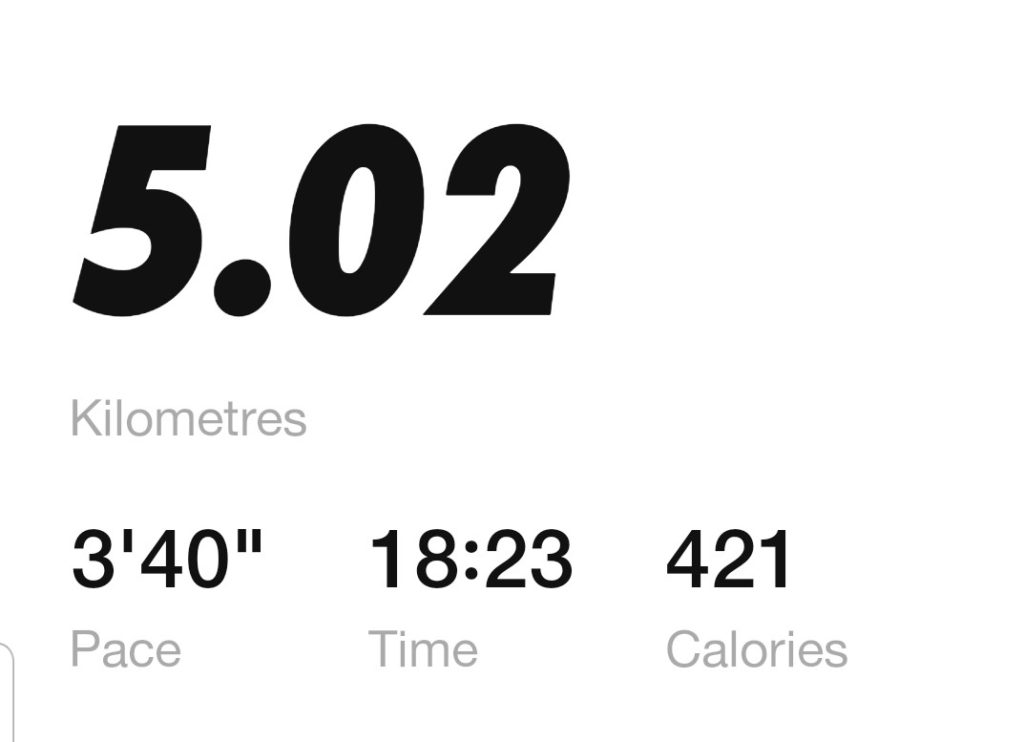Note: A more recent edit of this article has been published on The Ascent. To read that, click here!
…because running was a necessary function of survival, somewhere Running is a strange activity to do. We’re not necessarily running anywhere specific, we’re not running from anything dangerous, we’re not running for our next meal either. Modernity has eliminated those factors from our lives.
Last month I took on a running challenge. I ran almost everyday and I ran a lot – a total distance of 263.48km.
Before this, I would have considered myself an amateur runner at best. In the past, I’d get into the groove of running 2-5km once or twice a week. My “long runs” would be around 10km. The long longest run I’ve ever done was somewhere shy of 20km.
I always thought it was an impossibility for myself to run so much. I’ve read about runners who would run triple digits within a month in preparation for half marathons, marathons, and ultra-marathons. Many elite runners can easily cover up to 160km a week. Of course, this is not something that is sustained indefinitely. There is a training program that’s followed. Nevertheless, the sheer volume of it all is mind-boggling.
To me, running more than 100km within a month was an elusive distance that was only available to the fittest of the fit. I never registered distances in the three digit realm per month as a possibility for myself.
My understanding of this self imposed limiter was purely mental. I stand by the rule of fractions, because for every doubt that’s bred out of ignorance or fear, there’s a Dean Karnazes (this man completed 50 marathons in 50 days, among other amazing feats of superhuman capacity) or a David Goggins (considered one of the greatest endurance athletes today) out there proving otherwise. Again, absolutely mind-boggling!
So what exactly were my limiters? Why did I hide behind them for so long? I’d like to explore a couple of reasons:
1) I Didn’t Want To Put In The Work
Let’s face it, running close to and more than 100km within a month sounds daunting. The idea of covering a total distance that you are normally prepared to do in a vehicle for a day trip sounds off putting. It’s effort and work and sweat and pain. But the return is incredible — more on that later.
2) It Sounds Hard
And it was! Getting up almost everyday to go for a run in the morning and/or capping the night off with a run takes a lot of determination, willingness, grit, and dedication. There were times where I thought to myself, I could be doing something a little more relaxing. Although those thoughts didn’t manifest too often — I ended up enjoying my runs quite a bit. It really forced my mind to be in the present moment.
3) There’s No Way I’ll Ever Be Able To Run As Fast As The Pros
I allowed myself to believe that I just didn’t have what it takes. My genetics just weren’t up to par – there’s just no way I can compare to all of the amazing athletes out there. I gave it more power than it deserved – to the point that I just didn’t try at all.
What exactly is the benefit with this type of thinking? Boxing achievements into the category of “talent only” disregards all of the effort and hard work that have been put in by those who excel at what they do. There’s no winning with that type of mindset. Everybody has to start somewhere if they want to progress at all.
4) I Can Get My Cardio Another Way
Often times, I looked towards doing high intensity interval training, high volume exercises, jump rope, or short bursts of sprinting. All of them are great ways to improve cardiovascular health, and up overall aerobic capacity. The fact is however, running is undeniably one of the best ways to improve our cardiovascular health – the added benefit of running is manifold: from improving our mental health to adding years to our lifespan.
Why Did I Run So Much?
Circumstances over the last three months took a toll on my physical fitness. From a finger injury (which I’m still healing from), to the closure of exercise facilities due to COVID19, and a body transformation that was a by product of a 10 day water fast I did in May (I lost close to 7.5kg during the fast!) — I wasn’t anywhere near where I’m used to being in terms of my fitness levels.
So for the month of June, I said to myself, I’m going to try and get as fit as possible by the end of the month! Funnily enough, shortly after I made that resolution, I was invited to participate in a running challenge with a couple of friends.
The group goal was to run 120km before the end of June, with a stretch goal of 241.4km. I didn’t even know what a stretch goal was, but I’m glad I was introduced to the concept of it.
Stretch Goal
Simply put, a stretch goal is an ambitious target you aim for that far exceeds your “actual” goal. It makes so much sense — this way you go in with the mental determination of having to smash through your goal quicker than you intend to. What a brilliant concept!
120K

A few things occurred in the first 120K that shifted my mindset from “this is crazy” to “I think I can achieve the stretch goal.”
Doing this challenge with friends who are avid runners – and not to mention who have also accomplished multiple marathons, really established the benchmark for me. They set the precedence for what is humanly possible as I was watching through the Nike Run Club App the amount of distance they covered everyday.
Another huge asset to my mentality was that I didn’t want to fall behind too much. I am not one to be overtly competitive. It doesn’t matter very much to me whether or not I win or lose when competing with others. However, it was important for me to keep up because I wanted to enjoy the friendly competition. I wanted to stay in the game! The mental impact of striving for a collective goal kept my head in the right space.
What really did it for me was when my friend Lauren (10x marathon runner) mentioned to me: don’t worry about your times, just focus on putting in the mileage. It really took the pressure off. The advice itself seems so obvious, but as an amateur runner, I didn’t know how to change my perspective to make the process of running more enjoyable.
My approach to running was always: if I want to improve, just run faster. Run faster and finish the distance! If I couldn’t keep my pace and cadence steady, then I just need to push myself to train harder next time. Spoiler: that approach never worked. I was always stumped whenever I timed myself for my 5K trials. I was consistently running my 5K’s within a time of 27-30 minutes.
Mental Gains From Running Almost Everyday

Focus On Your Next Step
Running is a strange activity to do. We’re not necessarily running to any specific location. We’re not running from anything dangerous. We’re not running for our next meal either. Modern day society has eliminated those factors from our lives.
Yet, we do it anyway! I have this theory based on our Darwinian relationship with running. In the distant past, we ran for the aforementioned activities – much of it to do with the goal of survival.
A survival state of mind demands that all unnecessary thoughts be muted. This way we can be fully present. Fully immersed in our environment. Fully in tune with our senses.
If you have a steady meditation practice, have spent a long amount of time camping in the back country, come across a life endangering situation, become so absorbed in a certain activity where you reach a flow state, or have even fasted for a long period of time, you probably have had a glimpse of this silence I speak of.
My belief: because running was a necessary function of survival, somewhere along the way in our evolution a neural coupling occurred that allowed our body to tap into the mindset of being present. At least this is how I interpret one aspect of the “runner’s high” sensation.
Getting into the stride of my runs, I learned to tune out thoughts of running to accomplish a goal (even though that was what I was running for). Instead, I set my main focus on taking the next step, and then the next step, and the one after that. This took the pressure off on how much distance I had left to cover, or how fast my pace was. It kept me in the moment. It kept my mind clear like a cloudless sky. It was only 11 days into the month of June and before I knew it, I had completed the first 120K.
Pain Is Unavoidable
Mental and physical fatigue can always be looming around the corner. Physical pain can creep up sometimes during a run – whether it’s a minor cramp or soreness in legs, hips, and the core. I found that it’s better to forge through the pain instead of letting the momentary pain rule my existence. More often than not, pain that would peep its ugly head during my run would disappear soon after.
I’d like to add that none of the pain I experienced was debilitating and stemming from any major injuries. Much of the pain that I’m talking about was due the demands I was placing upon my body by running everyday. The sudden shock of the new routine required muscles that I don’t use as frequently to exert more effort than my previous norm.
Perhaps this is an analogy for life: pain is unavoidable, it will come with as much certainty as it will pass. It’s how receptive you are to accepting the pain – your body is a lot more resilient than you believe it to be!
Daily Exercise Kept My Mind Sharp
Old news here. There’s plenty of information out there that corroborates this truth. What I found that was particularly intriguing was how much my mood factors into mental sharpness.
Mental acuity is our ability to focus and process information. It is the speed of our memory recall. It is one of the things we all hope to maintain as we age – to be mentally “with it”.
Starting my mornings off with a run set the tone for the day (getting after it!). It was like brushing my teeth, but for my cardiovascular system. There were some days where I didn’t run until the afternoon or evening to allot for recovery time. However, because of the consistency of my runs, the mental clarity would carry over for 24-48 hours.
The biggest benefactor of having a clear mind and setting the tone for the day was how it impacted my mood. When we get into a mental funk or when our mood fluctuates, it can become quite detrimental to our daily performance.
In part, finishing a workout gives you a sense of accomplishment. Accomplishment in itself is perceived by the brain as a reward. Your brain is flushed with dopamine and now it feels like you’re winning! To flip the script, if you’re filled with a sense of positivity like accomplishment, chances are, you can use that sensation to push back against your states of anxiety or depression.
If we think about our mood and emotions as a scaled spectrum where “negative” emotions sit on one end and “positive” emotions sit on the other – well, one would hope that you have experiences in life to fill up the positive side more!
The small victories I garnered from completing a run every day left me feeling like a winner. As I progressed throughout the month the rhythm of running often allowed me the time and mental space to enjoy a silent mind, work out ideas I have been toying with for a while, redirect suppressed emotions, and release pent up energy.
Performance Gains From Running Almost Everyday

Cadence Matters
Two things affect your running pace: cadence and stride length. Cadence is the amount of steps you take per minute.
For the majority of June, cadence was something I focused on a lot in order to improve my running. In the past, I thought the way to run faster was to push off with more power in order to take bigger strides. Not only is this damaging for the structure of the legs, but it’s just not sustainable for longer runs!
What I learned while running everyday was that if I wanted my legs to be in good enough shape to run tomorrow, I’d better minimize the impact I have on my joints by taking smaller strides. Of course, this would affect my pace and output, so in order to calibrate for that, I took more steps per minute!
Run Slow For Better Performance
A lot of what I’m finding online seems to corroborate this golden truth in running: run at a pace where you’re able to converse with somebody. In a previous article I discussed why activities that are low impact is advantageous to upping our fitness levels. In it, I speak about the concept of sustaining exercise at a sub-optimal level and keeping our heart rate at a sustainable zone in order to allow for our cardiovascular system to adapt over time, thereby upping our overall aerobic capacity.
James Fitzgerald of OPEX Fitness talks about the concept of ‘aerobic capacity’ in length. The way he puts it: when we speak about working our aerobic system, it means we are utilizing physiological pathways in the body that require oxygen to run the engine. Is the activity sustainable for a long period of time? If yes, it’s an aerobic exercise.
Sidebar: Yes, there is such a thing as anaerobic exercise as well – without getting too in depth into the science of it all, these are physical activities that require a very sudden burst of energy in order to sustain an activity at maximum output (usually quite short, think 100m sprints or a one-rep max lift). The body needs energy fast and the oxidative process takes time, so utilizing oxygen just won’t cut it.
We can easily measure whether or not an activity is sustainable by questioning its capacity for repetition.
Can your physical output be reproduced consistently? If you’re not able to engage in a given activity yesterday, today, tomorrow and perhaps even the day after – because of lengthy recovery times, or if your performance suffers significantly on subsequent trials – well whatever you’re doing is not so sustainable.
Ideally, exercising our aerobic capacity means we are not giving it our all every single time. We want to be working at sub-optimal levels in order to avoid shocking our central nervous system too much.
CNS fatigue (more colloquially known as overtraining) is a real thing! Certain side effects can be poorer general performance, to inhibition of muscle growth, to difficulty sleeping, and even a weakened immune system!
So what I mean when I say ‘run slow for better performance’ is this: drop the mentality of pushing hard every single time. Training is termed training for a reason – it’s so that you can improve your body at a sustainable rate in order to mitigate injury. By doing so, when performance time comes, your body will be in the right shape it give it its all!
Which leads me to my next point.
Repetition Leads To Major Personal Bests
As I stated earlier, no matter how much effort I put in during my 5K runs, I would always yield a similar result. My average times would be around 25-30 minutes, depending on weather conditions.
The concept of sub-15 minute run times (held by elite athletes), really eluded me. Heck even sub-20 minute 5K runs made no sense to me. My mind just couldn’t understand how that was possible. I could only understand it in a way that these people are sprinting for the entirety of the 5K, which as I type this, sounds ridiculous.
However! Repetition works. Running everyday builds up this inner network that allows your central nervous system to adapt and eventually you will excel. Not to mention, you pack on some quality muscle in your legs from running often!
It’s like if you were to dig a small channel and introduce running water into this channel: at first, the water will trickle, but as time goes by and the running water erodes the sides of the channel to make it wider, larger volumes of water will pass through. More water passing through, faster flow.
So from that analogy, repetition paves a better CNS roadway for your muscles to work together in a more efficient manner. More muscular efficiency, better performance! This applies to every activity! The more you practice, the better your body will get at doing said activity.
I rested for roughly 30 hours between the run I had before testing my 5K time, and not to boast, but I broke a serious 5K personal best! After 3 weeks of consistent running – running slow and running often, the practice paid off in a huge way.

Being Active Everyday Made Me Eat Healthier
It seemed to me that my body just craved foods that were nutrient dense. Anything that I could put into my body that was hard to digest, high in processed sugar, or made me feel bloated, I shied away from.
It wasn’t for weight watching purposes. My mind didn’t even register that as a reason. The reasoning at the forefront of my mind was that I wanted to feel good. I wanted to feel good because I knew I’d have to do it all over again tomorrow. Given the option, I’d rather do a run feeling good in my body, than to do it feeling sluggish – because the pain is going to be inevitable, so why add to the load?
Eating healthier was one thing. I found I also ate a lot more! My metabolism shot up significantly – I was hungry all of the time.
Perhaps this is where having a good connection to our body starts – by pushing it to perform for us on a regular basis.
This challenge has certainly changed my mind about how I approach running. I love the way it makes my mind and body feel. The added endurance my legs have developed from the training is a bonus!
Special thanks to Lauren for keeping me on track, Mikey for the tips and @runrx for the helpful videos that kept me running mostly pain free!






